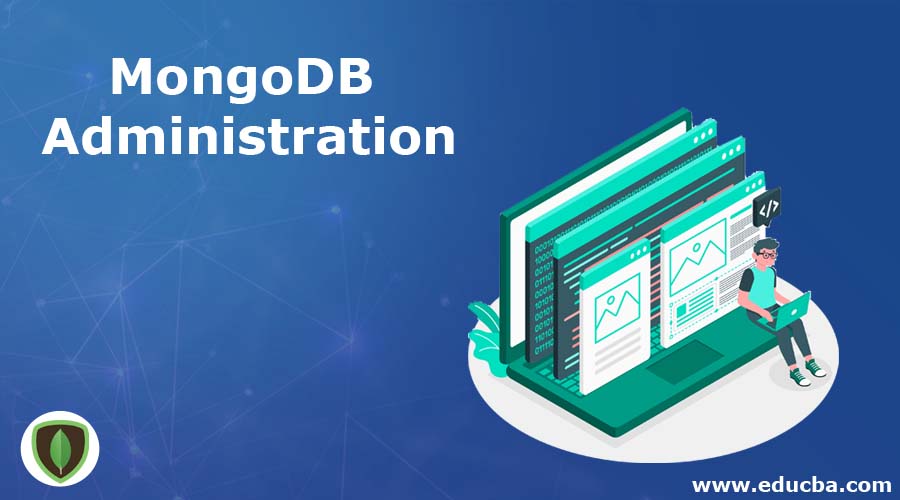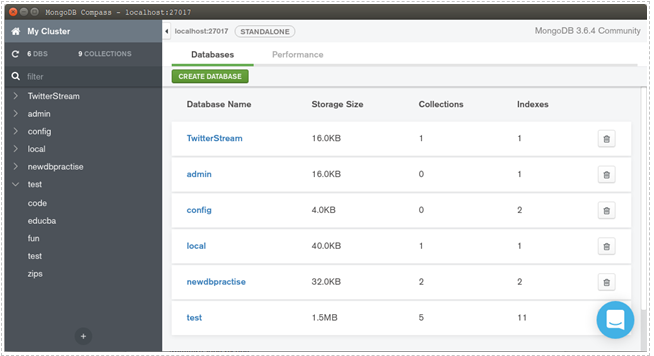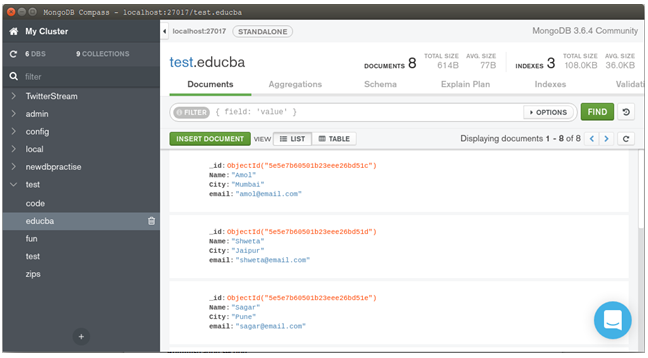Updated February 28, 2023

Introduction to MongoDB Administration
MongoDB Administration is responsible for Maintaining and Updating the Database, along with Checking for Updates and Possible Security Points. Major Task includes Installation, Configuration, Database Design, Monitoring, Troubleshooting, Backup, and recovery. Every Database has particular roles like User and Administration. The Admin role has the ability to execute administrative tasks. Major tasks related to Schema, gathering data and indexing. MongoDB Administration is a task of maintaining and managing the MongoDB. One of the most critical tasks is Database Sharding to be completed by the MongoDB Administration. The whole database is divided into smaller parts that are faster and far easily manageable and are called Data Shards.
The above screenshot reflects the Graphical Interface for the MongoDB, using MongoDB Compass.
Why Do We Need a MongoDB Administration?
For any organization that depends on one or more MongoDB databases, MongoDB Administration is an essential function. The core responsibility of managing the ongoing operations like Indexing, Storing, etc., are essential, and we always need a dedicated resource to handle and perform such a task. MongoDB Administration is a single point place to monitor all activities, look for bugs, update the system, and repair security defects.
Other than Database Security and Monitoring, major tasks are maintaining database performance, Data Dictionary, and standard security rules. Database recovery is a crucial operation carried out over the database and must be performed by trained resource. Setting up documentation and maintaining the same is mandatory for administration. One of the most important techniques is distributing the workloads around the whole database efficiently to maintain network efficiency and capacity.
These are the tasks that the MongoDB administration undertakes. One of the most critical skills required while handling MongoDB Administration is Database Recovery. Administration work is repetitive, complex and time-consuming, but since these databases hold data very important to the organization, skilled and trained persons are employed. Now that we have understood what MongoDB Administration is and why we need t let us understand how it works and tasks undertaken.
How Does MongoDB Administration Work?
MongoDB Administration aims to fulfil the full set of tasks performed by a trained database administrator to make sure that the database is always up and running with full capacity.
Below are the common tasks performed on MongoDB Administration Level:
- File-system Operations
- Replication
- Sharding
- Hardware
- Deployments
- Backups
- Monitoring
- Load Balancing, etc.
Under every task mentioned above, several functions need to be carried out successfully in order to MongoDB to function properly.
MongoDB Administration aligns the whole available disk by partitioning based on RAID Standards. Managing Hardware for the database is important, RAID10 and SSD drives are used for better performance on MongoDB level. To maintain Backups, Periodic tests are scheduled for the backup and restore process. Monitoring Hardware statistics for the server is an important aspect. Factors like Disk Use, CPU and free space on disk are important. Above mentioned are the various ways in which MongoDB Administration works, let us now understand the roles for MongoDB Administration.
Roles of MongoDB Administration
The roles can be categorized as Development, Administration, Performance, etc. Below are the duties that MongoDB Admin has:
1. One of the most important tasks is to Monitor Database, along with regular backups and restoring when demanded. Security for any Database is important, and as an Admin, it is essential to make the Database foolproof.
2. Deployments are key responsibilities of a DBA. Adding new deployments, either Manually or Automated, designing deployments, etc.
3. Development related tasks are Reporting, where an admin usually writes a script that is supposed to be executed regularly and returns data used for reporting purpose. Designing Database and Modeling is one of the most important tasks as an admin. Staging and Development are the two basic databases where queries must be executed by admin when needed.
4. Continuous checking for the performance of the database is crucial with perspective to stay active. Creating Indexes as per requirement and database sharding is performed on the part of MongoDB administrations. For every issues or performance issue, reports must be sent to other teams.
5. In matters with replication, use hostnames when setting new replica sets, instead of IP Addresses. Ensure to establish Bidirectional Connectivity between Mongod instances. Allowing each separate host to repair itself when in the issue. Also to ensure mongod instances have 0 or 1 votes and must contain an odd number.
6. MongoDB Administration role with Sharding: Place config serves on large clusters for better performance. Usage of NTP for Clock Synchronization. Full bidirectional connectivity between all mongos, mongod and config servers.
Advantages of MongoDB Administration
Below are the advantages:
- For any Database, it is crucial to have a centre point where every transaction is monitored; updates are searched for and installed. New deployments are to be made. All these tasks are carried out efficiently under MongoDB Administration section.
- One of the major advantages of having a MongoDB Administration is that the end-users have access to a stable database system. Providing such access for end-users makes it better for them to work on the database environment.
- Data: By storing all elements of data at one place, minimum redundancy is required. Data is stored easily with every possible inter-relationships between files established. Role of Data Security and Integrity is performed well. Access to data and responsiveness.
- Basically, all these advantages lead to a better database system and help for better productivity.
You can see the graphical arrangement of the documents in the educba collection within test collection in the above screenshot.
Conclusion
To Conclude, it is important to have a dedicated area for administrating the whole MongoDB Database. Many crucial operations are performed at ease with the MongoDB Administration section. Better speed and data safety, along with Security and access to data, are provided. Replication, Sharding, Backups are few of the critical tasks performed on MongoDB Administration level. Deploying the replica sets into a minimum to three data centres will result in high availability of space.
Recommended Article
This is a guide to MongoDB Administration. Here we discuss how Does MongoDB Administration Work and its different Rolls along with its advantages. You can also go through our other suggested articles to learn more –


